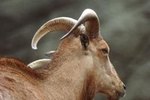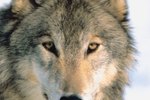
The Kermode bear is native to British Columbia in Canada. The bear, which is the official animal of the region, is a subspecies of the American black bear. About 10 percent of Kermode bears have white fur, earning them the alternative Native American name of "Moksgm'ol" or "spirit bear." Logging and road building threaten the habitat and diet of the Kermode bear.
Kermode Bear Diet
This bear likes to live around coastal areas of British Columbia, although you won't find him in areas where there is a human population. Dense forests with plentiful water sources provide the perfect habitat for his diet, which is primarily made up of his favorite fish, salmon. According to the Ian Somerhalder Foundation, in 2009, a study showed that white Kermode bears can catch more salmon than any other bear because of his color. He also likes to eat berries, nuts, green plants and small rodents. The relationship between what the bear eats and his survival, plus the survival of his environment, is delicate.
Salmon Saves the Forest
The Kermode bear's salmon consumption plays a vital role in supporting his habitat according to Planet Releaf. The tree canopy of his temperate rainforest home protects the streams teeming with salmon. The trees also provide him with hibernation spots for the cold winter months, and the bear helps sustain tree growth by dropping the remains of his salmon dinners on the forest floor, providing nutrients for the trees. Planet Releaf points out that the Kermode bear's habitat is the last and largest temperate rainforest on the planet, and that damage to either destroys both.
Effects of Logging
A five-year scientific study sponsored by the Valhalla Wilderness project concluded that logging and road building had destroyed the Kermode bears' habitat extensively. The bears' food supplies and "denning" places, where they give birth and raise their young, were threatened. The bears consume huge amounts of salmon in the fall to build themselves up for winter hibernation, and logging also destroys salmon breeding grounds as well as the bears' forest home. Logging also has pushed grizzly bears into the Kermode bears' territory, presenting another problem; competition for salmon.
Kermode Bear Protection
In 2009, the government of British Columbia completed legislation to protect the Kermode bears' habitat, particularly around the area of Princess Royal Island, which has the densest population of Kermode bears. The law only allows logging in designated areas, so that the ancient forest ecosystem that provides the bears with food is protected. It is hoped that controlling access to the Kermode bears by giving them a protected area also will prevent trophy hunters getting to them. Human activity plus the Kermode bears' low birth rate are a combined threat to this rare bear's existence.
References
Photo Credits
-
Jupiterimages/Photos.com/Getty Images
Writer Bio
Based in London, Eleanor McKenzie has been writing lifestyle-related books and articles since 1998. Her articles have appeared in the "Palm Beach Times" and she is the author of numerous books published by Hamlyn U.K., including "Healing Reiki" and "Pilates System." She holds a Master of Arts in informational studies from London University.




